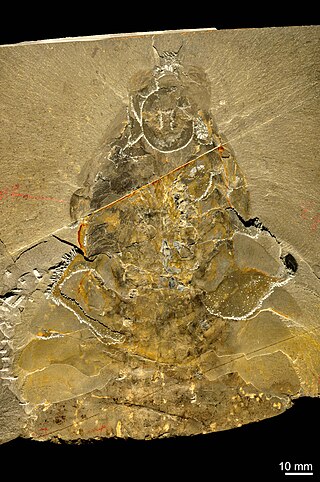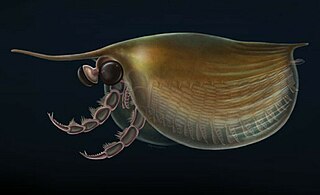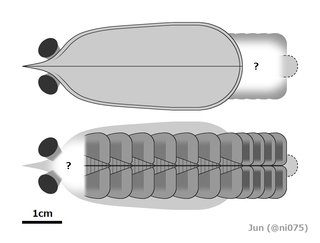
Yohoia is an extinct genus of megacheiran arthropod from the Cambrian period that has been found as fossils in the Burgess Shale formation of British Columbia, Canada. The type species, Yohoia tenuis, was described in 1912 by Walcott, who considered it an anostracan crustacean. 711 specimens of Yohoia are known from the Greater Phyllopod bed, where they comprise 1.35% of the community. In 2015, Conway Morris et al. reported another species, Y. utahana, from the Marjum Formation, Utah.

Megalograptus is a genus of eurypterid, an extinct group of aquatic arthropods. Fossils of Megalograptus have been recovered in deposits of Katian age in North America. The genus contains five species: M. alveolatus, M. ohioensis, M. shideleri, M. welchi and M. williamsae, all based on fossil material found in the United States. Fossils unassigned to any particular species have also been found in Canada. The generic name translates to "great writing" and originates from the mistaken original belief that Megalograptus was a type of graptolite, often given names ending with -graptus.

Peytoia is a genus of hurdiid radiodont, an early diverging order of stem-group arthropods, that lived in the Cambrian period, containing two species, Peytoia nathorsti from the Miaolingian of Canada and Peytoia infercambriensis from Poland, dating to Cambrian Stage 3. Its two frontal appendages had long bristle-like spines, it had no fan tail, and its short stalked eyes were behind its large head.

Jianfengia is an extinct genus of Middle Cambrian (Atdabanian) megacheiran arthropod found in the Maotianshan Shale Lagerstätte of China. It contains the single species Jianfengia multisegmentalis. The body is extremely elongated, though the animal itself was relatively small at less than 4 centimetres (1.6 in) in length. The head has a pair of stalked eyes, a hypostome/labrum complex, a pair of great appendages with five podomeres, and four pairs of biramous limbs. The maximum known number of trunk segments is 27, though most known specimens have 20, which are associated with pairs of biramous appendages, and the body ends with a telson spine. It has been placed as a member of the family Jiangfengiidae, alongside Fortiforceps and Sklerolibyon as well as possibly Parapeytoia.

Amplectobelua is an extinct genus of late Early Cambrian amplectobeluid radiodont, a group of stem arthropods that mostly lived as free-swimming predators during the first half of the Paleozoic Era.

Parapeytoia is a genus of extinct arthropod that lived over 530 million years ago in the Maotianshan shales of prehistoric China. It was interpreted as an anomalocaridid (radiodont) with legs, but later studies reveal it was a megacheiran, a group of arthropods which are no longer thought to be closely related to the radiodonts.

Megacheira is an extinct class of predatory arthropods defined by their possession of spined "great appendages". Their taxonomic position is controversial, with studies either considering them stem-group euarthropods, or stem-group chelicerates. The homology of the great appendages to the cephalic appendages of other arthropods is also controversial. Uncontested members of the group were present in marine environments worldwide from the lower to middle Cambrian.

Haikoucaris is a genus of megacheiran arthropod that contains the single species Haikoucaris ercaiensis. It was discovered in the Cambrian Chengjiang biota of China.

Isoxys is a genus of extinct bivalved Cambrian arthropod; the various species of which are thought to have been freely swimming predators. It had a pair of large spherical eyes, and two large frontal appendages used to grasp prey.

Occacaris oviformis is an extinct nektonic predatory arthropod from the Lower Cambrian Maotianshan shale Lagerstätte. It bears a superficial resemblance to the Cambrian arthropod, Canadaspis, though, was much smaller, and had a pair of "great appendages", with which it may have grasped prey. It was originally considered to belong to Megacheira, however it is questioned in later study.

Radiodonta is an extinct order of stem-group arthropods that was successful worldwide during the Cambrian period. They may be referred to as radiodonts, radiodontans, radiodontids, anomalocarids, or anomalocaridids, although the last two originally refer to the family Anomalocarididae, which previously included all species of this order but is now restricted to only a few species. Radiodonts are distinguished by their distinctive frontal appendages, which are morphologically diverse and used for a variety of functions. Radiodonts included the earliest large predators known, but they also included sediment sifters and filter feeders. Some of the most famous species of radiodonts are the Cambrian taxa Anomalocaris canadensis, Hurdia victoria, Peytoia nathorsti, Titanokorys gainessii, Cambroraster falcatus and Amplectobelua symbrachiata, the Ordovician Aegirocassis benmoulai and the Devonian Schinderhannes bartelsi.

Eoredlichia is an extinct genus of trilobite of average to large size. It lived during the early Cambrian in the Chengjiang fauna of Yunnan, China, and in Australia and Thailand. Eoredlichia is compounded of the Greek ἠώς and Redlichia, a later but related genus, so it means "early Redlichia". The species epithet intermedia means intermediate, indicating it is morphologically intermediate between other species. Eofallotaspis gives rise to Lemdadella, and thence to Eoredlichia and the other Redlichiidae.

Diania is an extinct genus of lobopodian panarthropod found in the Lower Cambrian Maotianshan shale of China, represented by a single species - D. cactiformis. Known during its investigation by the nickname "walking cactus", this organism belongs to a group known as the armoured lobopodians, and has a simple worm-like body with robust, spiny legs. Initially, the legs were thought to have a jointed exoskeleton and Diania was suggested to be evolutionarily close to early arthropods, but many later studies have rejected this interpretation.

Kootenichela deppi is an extinct arthropod described from the Middle Cambrian of the Kootenay National Park, Canada. It is originally considered to be a member of "great appendage arthropods", although subsequent studies questioned its affinity. Kootenichela appears to be the sister taxon of Worthenella, from cladistic analysis.

Kylinxia is a genus of extinct arthropod described in 2020. It was described from six specimens discovered in Yu'anshan Formation in southern China. The specimens are assigned to one species Kylinxia zhangi. Dated to 518 million years, the fossils falls under the Cambrian period. Announcing the discovery on 4 November 2020 at a press conference, Zeng Han of the Nanjing Institute of Geology and Paleontology, said that the animal "bridges the evolutionary gap from Anomalocaris to true arthropods and forms a key ‘missing link’ in the origin of arthropods," which was "predicted by Darwin’s evolutionary theory." The same day the formal description was published in Nature.

Terropterus is a genus of eurypterid, an extinct group of aquatic arthropods. The type and only species of Terropterus, T. xiushanensis, is known from deposits of Early Silurian age in China.

Erratus is an extinct genus of marine arthropod from the Cambrian of China. Its type and only species is Erratus sperare. Erratus is likely one of the most basal known arthropods, and its discovery has helped scientists understand the early evolution of arthropod trunk appendages. Some of the stem-arthropods like radiodonts did not have legs, instead they had flap like appendages that helped them swim. Erratus on the other hand had not only flaps but also a set of primitive legs. It also supported the theory that the gills of aquatic arthropods probably evolved into the wings and lungs of terrestrial arthropods later in the Paleozoic.

Bundenbachiellus is an extinct genus of arthropod described from the Lower Devonian Hunsrück Slate of Germany. This genus is known from only one species, B. giganteus. Alongside its possible relative Enalikter from Silurian, it is possible that genus is late-living example of Megacheira, "great-appendage arthropod".

Fortiforceps is an extinct genus of Cambrian megacheiran arthropod known from the Chengjiang biota of Yunnan, China. It was originally described by Hou and Bergström in 1997, and redescribed in 2020. It was relatively small, at 4 centimetres (1.6 in) or less in length. The head had a large pair of stalked eyes, a pair of frontal projections, as well as a pair of great appendages, like other megacheirans, along with two other cephalic appendages. The trunk had either 20 or 22 segments, depending on the specimen. These segments had pronounced blade-like spines on their upper-outer edge. Each of the trunk segments were associated with pairs of biramous limbs, which probably have seven podomeres and like other megacheirans, have paddle-shaped exopods. The trunk terminated with a forked tailpiece, which on their outer edges had rod-like structures. The two lobes were separated by a rectangular central piece. It has been placed as a member of the family Jiangfengiidae, alongside Jianfengia, Sklerolibyon and possibly Parapeytoia.

Oestokerkus is an extinct genus of Cambrian megacheiran arthropod known from the Emu Bay Shale of Kangaroo Island, Australia. It belongs to the family Leanchoiliidae. It had a large head shield that was more than a third of the trunk's length, as well as a large pair of eyes. The great appendages have long flagellae projecting from them. The head shield probably had two pairs of cephalic appendages. The trunk has 11 segments. The exopods of the biramous limbs are fringed with long setae. The body ended with a telson, which was probably dorsally flattened.























